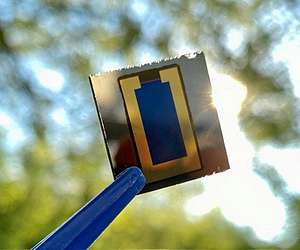On the 11th (Wednesday), DGIST announced that the research team led by Professor Choi Jong-min of the Department of Energy Engineering at DGIST (President: Kuk Yang) enhanced light absorption capacities and photocurrent generation of solar cells by implementing a nano-structured electrode on the back of the perovskite quantum dot solar cell, which is in the limelight as a next-generation solar cell.
In addition, the team has systematically verified the correlation between the shape of the nanostructure and the efficiency of the solar cell and the optimized conditions for the formation of nanopatterns in organic materials. It is expected that the team’s achievements can be applied to various photoelectric devices using organic materials.
Interest in solar cells, which is a new renewable energy source, has been building up recently. Research on solar cells using quantum dots is also active. In particular, in the field of quantum dot solar cells, perovskite quantum dot solar cells have recently been in the spotlight as a next-generation solar cell because energy generation efficiency is rapidly increasing.
The efficiency of a solar cell is mainly determined by its ability to absorb light and transmit electric charges generated by light to the electrode. Although perovskite quantum dots have excellent photoelectric properties, they have limitations in generating photocurrent as they do not form a thick light absorption layer when manufacturing a solar cell.
Meanwhile, the research team led by Professor Choi Jong-min of the Department of Energy Engineering at DGIST succeeded in enhancing light absorption and photocurrent while maintaining the thickness that optimizes the amount of charge extraction by forming the rear electrode of the perovskite quantum dot solar cell into a nanostructure.
The research team successfully embodied a rear nanostructure electrode by forming a nanopattern on the hole transport layer of a perovskite quantum dot solar cell through a nanoimprint lithography and uniformly depositing an electrode material on top of it along the curves of the hole transport layer nanopattern.
In addition, the research team formed nanostructured rear electrodes of various heights and cycles to verify the relationship among the shape of the nanostructure, the light absorption ability, and the electrical loss of the solar cell due to nanostructure.
Afterwards, the team designed optically and electrically effective nanostructured rear electrodes and optically enhanced the light absorption capacity of the solar cell and maximized the efficiency of the solar cell without electrical loss.
In addition, the team verified the optimal conditions for nanoimprint lithography based on the relationship between the glass transition temperature and flexibility of organic materials, which are widely used as charge transfer materials for photoelectric devicess including solar cells.
These achievements are expected to contribute to research on the formation of nanopatterns of various photoelectric devices using organic materials as charge transport layers in the future.
Meanwhile, this research is the result of a joint research conducted with Professor Kim Yeong-hoon’s team at Kookmin University and Professor Baek Se-woong’s team at Korea University and was led by Han Sang-hoon, a Combined Master/Ph.D. student at DGIST. In addition, this study was funded by the National Research Foundation of Korea, the DGIST R and D Program, and new research project subsidy provided by the National Research Foundation of Korea.
Related Links
Daegu Gyeongbuk Institute of Science and Technology
All About Solar Energy at SolarDaily.com
|
We need your help. The SpaceDaily news network continues to grow but revenues have never been harder to maintain. With the rise of Ad Blockers, and Facebook – our traditional revenue sources via quality network advertising continues to decline. And unlike so many other news sites, we don’t have a paywall – with those annoying usernames and passwords. Our news coverage takes time and effort to publish 365 days a year. If you find our news sites informative and useful then please consider becoming a regular supporter or for now make a one off contribution. |
||
|
SpaceDaily Contributor $5 Billed Once credit card or paypal |
SpaceDaily Monthly Supporter $5 Billed Monthly paypal only |
|

![]()
Thin-film photovoltaic technology combines efficiency and versatility
Karlsruhe, Germany (SPX) Jun 29, 2022
tacking solar cells increases their efficiency. Working with partners in the EU-funded PERCISTAND project, researchers at the Karlsruhe Institute of Technology (KIT) have produced perovskite/CIS tandem solar cells with an efficiency of nearly 25percent- the highest value achieved thus far with this technology. Moreover, this combination of materials is light and versatile, making it possible to envision the use of these tandem solar cells in vehicles, portable equipment, and devices that can be folded o … read more
